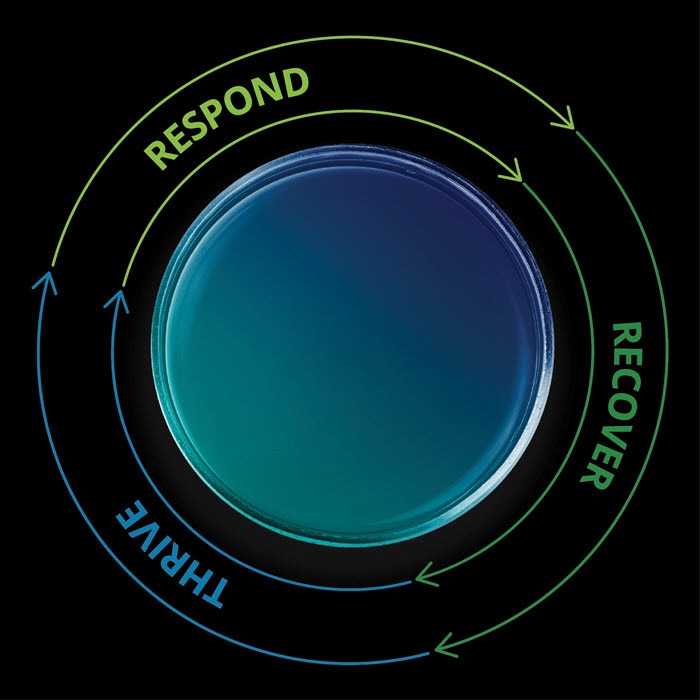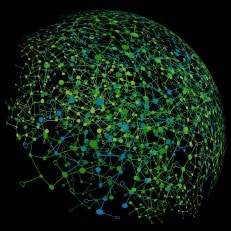Building a more resilient government supply chain has been saved

Perspectives
Building a more resilient government supply chain
Positioning an agency’s supply chain to be a strength during times of disruption
As agencies continue working to recover from COVID-19, they must prioritize transforming their supply chain management practices to prepare for future disruptions. By acting now, government agencies can fortify their supply chains to enable them to thrive and better protect the public they serve.
Understanding the importance of supply chain resiliency
Supply chains are the backbone of many government agencies. Historically treated as a back-office function, commercial and public sector entities are realizing success links inextricably to supply chain performance. If you want to run a mission-ready organization that delivers value to the public, hits its KPIs, and remains resilient in times of disruption, then you must ensure your operations and supply chain management practices are set up for success.
The compounded impacts of the coronavirus (COVID-19) and subsequent government actions to preserve public health are a prime example of how unanticipated events can materially affect the supply chain. What could have been a source of strength during times of disruption materialized as a wake-up call for many government agencies that were unprepared to handle such a shock to the system. For example, the shortage of domestically available personal protective equipment (PPE) highlighted the extent to which government agencies are reliant on foreign manufacturers and suppliers for critical public health and national defense materials.
Supply chain risks common to government agencies
Government agencies have unique roles in the community, especially during times of crisis when their supply chain infrastructure becomes critical to the community. In many respects, government supply chains need to be more resilient than their commercial counterparts.
Below are five common pitfalls that government agencies face in the wake of a supply chain disruptor event:
| Supplier base In today’s business environment, most supply chains have a global reach, including those of government agencies. The primary risk faced by most government agencies with respect to the supply base is a lack of visibility into the supplier ecosystem beyond tier 1 suppliers. For government agencies, understanding the origin of critical components, as well as the market strength of those companies supplying critical components, should be a priority to prevent the crippling effects to the entire supply chain caused by disruptions to lower-tier suppliers. |
|
| IT modernization and security Government agencies struggle with aging IT infrastructure and systems that are becoming increasingly obsolete, costly to maintain, and vulnerable to cyber threats. Many of these aging systems have poor interoperability with more contemporary IT solutions, thus hindering the adoption of modern and more cost-effective solutions throughout the supply chain. |
|
| Coordination and communication Unlike most commercial organizations, where the supply chain exists to serve that organization, government agency supply chains can work to serve a wide variety of end users. Depending on the disruptor event, government agency supply chain responses may require coordination between all levels of government—local, state, and federal—as well as cross-agency and private and public coordination. Breakdowns in communication can lead to overpurchasing and underdelivering of supplies or bottlenecks in delivery. |
|
| Inventory management Because of poor inventory management systems, government agencies often struggle to optimize inventory control and effectively monitor when items need to be reordered and restocked. Without visibility across the supply chain, inventory replenishment can come in the form of extra, unnecessary purchases instead of the transfer of existing inventory from a separate location to the point of need. |
|
| Procurement Inefficient procurement processes often plague government agencies. Long lead times from the requirements development process to contract award can exacerbate other supply chain issues. Additionally, the single focus on cost can cause the procurement function to be purely transactional. This approach misses out on the opportunity for government agencies to leverage the procurement function as a driver of value to the larger organization in terms of improved performance and the ability to capture innovation from the supply base, in addition to lowering the prices paid for common services and products. |
Creating resiliency
Resilient supply chains are flexible enough to resist breaking under strain, yet have the capacity to return to a normalized state during recovery. Improving resiliency does not happen by chance or overnight. It requires thoughtful leadership and a well-designed strategic plan that is tailored to meet the specific requirements of your organization. Leading organizations in both the commercial and government sector are taking steps to ensure their teams are not only responding to the immediate needs resulting from a supply chain disruption, but also preparing for inevitable future disruptions.
These following four pillars are essential to establish and maintain a secure supply chain in an uncertain future:

The four pillars explained
One of the best ways government agencies can build supply chain resiliency is by illuminating the supplier base. This insight enables agencies to diversify suppliers and improve strategic sourcing and procurement. Understanding how services and products flow across the value chain allows an organization to validate and identify a cost-effective network needed to achieve the desired service level. Also, it spreads risk and mitigates the impact that social, political, and geographic incidents could have on material impact on price and availability. Additionally, it can uncover domestic and foreign threats, including counterfeit parts, hostile foreign direct investments, and high-risk, financially unstable private entities.
Visibility in action
Deloitte worked with a national security agency to perform supplier base due diligence on chemical components of a sanitizer product for food processing. Using Deloitte’s CentralSight™ software to illuminate key component suppliers revealed they were all obtaining the key chemical component from the same manufacturer in China. With the resulting information, the agency was able to clearly assess their foreign supplier risks, determine alternative sourcing opportunities, and outline cost savings.
Traditional supply chain models and functions are transitioning from manual processes and disparate systems to centralized supply chain networks backed by robust technology. Intelligent workflows and data-driven demand insights are relatively new concepts that are rapidly becoming the new status quo. Rather than viewing supply chain functions as merely transactional, leading organizations are using their digitized supply chains to increase organizational resiliency.
COVID-19 has highlighted the need for government agencies to accelerate their adoption of mission-critical supply chain technology, automation, and digitization solutions. Forward-thinking organizations have taken this a step further by adopting technologies that support remote collaboration and coordination across supply chains, including:
● Artificial intelligence and machine learning
● Robotic process automation
● Internet of Things
● Blockchain
● Advanced analytics
● Digital and additive manufacturing
All of these enabling technologies can be managed from a supply chain control tower that integrates key management functions into one central point of truth. These technologies (and many more) can help government agencies transition to data-driven, digital supply chains. The result is an ability to monitor and adapt in real time to changing circumstances, reducing the negative side effects from disruption.
A key step government agencies can take to help build in resiliency is a supply chain risk management review. When an organization does not have enough visibility across the extended supply network, it risks overreliance on a single geography or a single supplier for key products. The future of supply chain risk management calls for government agencies to perform greater due diligence when procuring new resources and to identify potential vulnerabilities. Before new supplier relationships are created, agencies will need to assess how secure and viable their critical suppliers’ business is by determining whether their suppliers can withstand downturned economies or other business threats. To mitigate current vulnerabilities, organizations should work with key suppliers to understand the flexibility they have to shift production and purchase order fulfillment to other locations. Active communication and formulation of alternative plans are critical to minimizing potential impacts due to unexpected supplier limitations.
Today, government agencies should implement a supply-chain risk management function in their portfolio aimed at identifying, evaluating, and planning risk response strategies. Some federal government agencies, such as the US Department of Defense and the Federal Emergency Management Agency, already use frameworks designed to predict and assess the impact of high-risk, low-probability (also known as “black swan”) events. Assessment determines whether the current risk management approach fully meets the needs of the government agency and whether it is prepared to quickly adjust and recover from any unanticipated supply chain disruptions that occur. Leading government agencies are realizing that supply chain risk management is an enterprisewide affair and are actively pulling in agency leaders to the process.
Where to start
A logical and cost-effective starting point is a supply chain resiliency assessment. This exercise can help government agencies identify specific areas, such as process redesign, technology upgrades, or supplier diversification, for further exploration and evaluation. The first step in conducting this assessment is to develop an operations maturity model, either by using stakeholder inputs to conduct a gap analysis or using supply chain simulation software that highlights key areas for improvement and potential investment. Once these improvement areas have been identified, government agencies can assess the trade-offs by using cost-benefit analyses, impact assessments, and risk management frameworks. Some mission requirements may require teams to take assessment a step further in the form of wargaming or supply chain stress tests.

The importance of acting now
The decades-long concept of a lean, agile, and global supply chain is unsustainable when placed under extreme duress. Unfortunately, it appears the current pandemic will continue to have rippling effects in our communities.
- Continuous disruption from COVID-19: Experts have predicted multiple waves of COVID-19 outbreaks over the next 12 to 18 months.
- Economic uncertainty: The pandemic’s economic challenges continue to ripple around the world.
- Likely future disruptions: As supply chains continue to expand globally in an increasingly complex, interconnected network, so does the likelihood and impact of similar disruption scenarios.
- National security: A spotlight has been cast on supply chain deficiencies. With the proliferation of cyberattacks by bad foreign actors, we could begin to see the chronic exploitation of global supply chain functions.
Government must fortify their operations now with the technology and expertise needed to emerge more resilient and ready to thrive in the next age of supply chain management.

Recommendations
Government Supply Chain Management and Modernization
Mastering the art of government resilience



